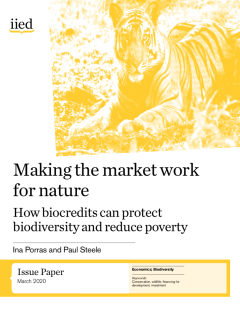
Tackling biodiversity loss is a growing priority for human survival. Introducing incentives for positive actions could play a key role in helping to reverse this loss. This paper explores the potential of using a novel approach to promote biodiversity conservation. It explains the concept of biodiversity credits or ‘biocredits’, describing them as coherent units of measurement that track conservation actions and outcomes and can help improve tracking and transparency.
This paper then examines the potential for developing countries to put in place a national biocredit scheme which allows them to be sold domestically and internationally, and which promotes fair benefit sharing with rural populations. It draws lessons from related incentive schemes within carbon markets, especially REDD+ and voluntary community carbon offsets, as well as from wider examples of payments for ecosystem services (PES) schemes. The paper explains that much can be learnt from experiences with these related incentive schemes, which include species conservation banking (US), eco-credits (Germany), a national PES scheme (Costa Rica) and wildlife credits (Namibia).
Based on the literature reviewed, the paper identifies ways to develop a national biocredit scheme in a developing country. To date, no such biocredit scheme exists, but this paper sets out four innovative key building blocks or characteristics needed to implement a biocredit scheme:
• Simple, transparent and cost-effective design
• Enabling policy from government for implementation
• Market engagement to attract buyers and generate sales
• Inclusive and fair benefits for local people
The paper concludes by suggesting that done properly, biocredits may develop into a viable option to improve biodiversity conservation and reduce poverty.
